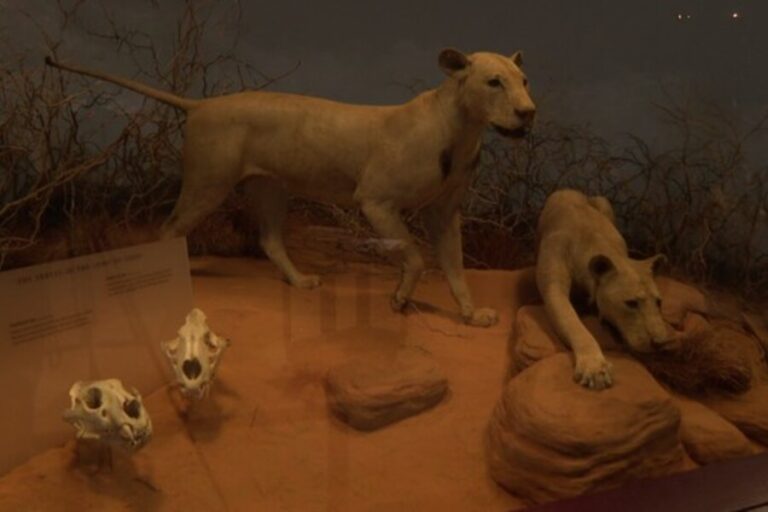The Field Museum of Natural History is celebrating a century since the arrival of its famed man-eating Lions of Tsavo. Originally brought to the museum as rugs, these legendary predators from Kenya were later transformed into lifelike taxidermy exhibits that have captivated generations of visitors.
The Lions of Tsavo have become iconic fixtures at the museum, displayed in the Rice Gallery alongside other African mammals. For many visitors today, the lions are a popular backdrop for selfies. However, in 1898, encountering these lions was a far deadlier experience.
The story of the man-eating lions begins with the British construction of a railway bridge over the Tsavo River in modern-day Kenya. The two male lions, which were unusually large and maneless, began preying on workers, causing widespread fear. Work on the railway came to a standstill as efforts to scare the lions away failed.
Lt. Col. John Henry Patterson, the engineer overseeing the project, eventually hunted and killed the lions after a terrifying nine-month ordeal. Patterson later chronicled the events in his book, The Man-Eaters of Tsavo and Other East African Adventures, claiming the lions had killed 135 people. However, scientific research conducted by the Field Museum suggests the actual number was closer to 35.
Assistant collections manager Tom Gnoske has studied the lions extensively over the years. To him, these specimens are invaluable. “They’re among the most important specimens in the museum,” Gnoske said. He even knows the lions by their catalog numbers: 23969 (the standing lion) and 23970 (the crouching lion).
The story gained further prominence through the 1996 film The Ghost and the Darkness, starring Val Kilmer. While the movie dramatized many aspects of the lions’ story, Gnoske recalls it with amusement. “I love that movie,” he said. “There’s a part where they claim the lions are killing for pleasure, and there’s this huge pile of bones. It’s a bit exaggerated.”
In 1996, Gnoske and his team discovered the real cave where the lions had dragged their victims. Unlike the dramatic depiction in the film, the cave was far less theatrical but still significant for researchers.
One of the most remarkable scientific breakthroughs came when Field Museum researchers analyzed DNA from a loose tooth belonging to one of the lions. The tooth, dislodged due to a broken socket, had trapped clumps of hair from the lion’s prey. DNA testing confirmed that the lions had indeed consumed human victims.
“The lion was eating people from the time it was around two years old,” Gnoske explained. The analysis also revealed that the two lions were brothers. Researchers speculate that injuries or a lack of natural prey may have driven the lions to target humans.
The Field Museum acquired the Lions of Tsavo in 1925, just four years after the institution opened its current location at 1400 S. DuSable Lake Shore Drive. Lt. Col. Patterson sold the specimens during a visit to Chicago. Since then, the lions have become one of the museum’s most renowned exhibits, drawing countless visitors eager to learn about their chilling history.
For museum-goers like Maria Gonzalez, the display offers both fascination and reflection. “It’s incredible to see these lions up close and think about what they did,” she said. “The fact that they halted an entire railway project is just astonishing.”
The Field Museum’s scientists continue to study the Tsavo lions to uncover more about their behavior and the environmental factors that led to their attacks. The exhibit not only tells a tale of fear and survival but also serves as a reminder of the complex relationship between humans and wildlife.
“They’re a symbol of the challenges faced in untamed environments and the consequences when those boundaries are crossed,” Gnoske said.
As the Field Museum marks 100 years since the acquisition of these legendary predators, the legacy of the Tsavo lions remains as compelling as ever. Through ongoing research and storytelling, the museum ensures that the history of these man-eaters continues to captivate and educate for generations to come.
